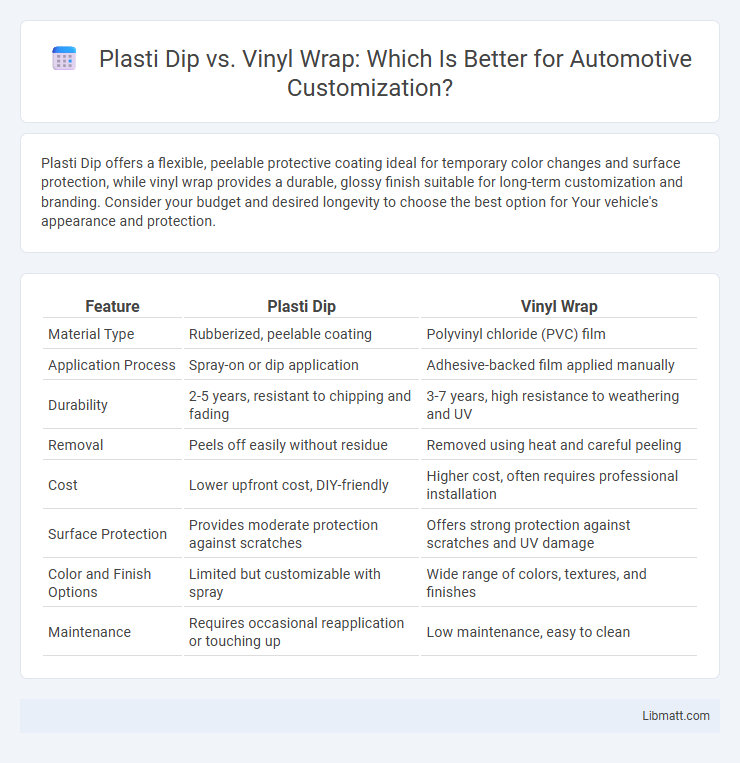Plasti Dip offers a flexible, peelable protective coating ideal for temporary color changes and surface protection, while vinyl wrap provides a durable, glossy finish suitable for long-term customization and branding. Consider your budget and desired longevity to choose the best option for Your vehicle's appearance and protection.
Table of Comparison
| Feature | Plasti Dip | Vinyl Wrap |
|---|---|---|
| Material Type | Rubberized, peelable coating | Polyvinyl chloride (PVC) film |
| Application Process | Spray-on or dip application | Adhesive-backed film applied manually |
| Durability | 2-5 years, resistant to chipping and fading | 3-7 years, high resistance to weathering and UV |
| Removal | Peels off easily without residue | Removed using heat and careful peeling |
| Cost | Lower upfront cost, DIY-friendly | Higher cost, often requires professional installation |
| Surface Protection | Provides moderate protection against scratches | Offers strong protection against scratches and UV damage |
| Color and Finish Options | Limited but customizable with spray | Wide range of colors, textures, and finishes |
| Maintenance | Requires occasional reapplication or touching up | Low maintenance, easy to clean |
Introduction to Plasti Dip and Vinyl Wrap
Plasti Dip is a removable rubberized coating known for its flexibility, durability, and ease of application, making it ideal for temporary vehicle customization and protection. Vinyl wrap, composed of thin, adhesive-backed vinyl film, offers a wide range of colors and finishes, providing a more permanent and visually striking alteration to your vehicle's exterior. Both options enhance your vehicle's appearance while delivering protection, but their differences in longevity, texture, and application techniques cater to varying customization needs.
Material Composition and Properties
Plasti Dip is a synthetic rubber coating composed primarily of polymers and resins that offer flexibility, durability, and resistance to moisture and UV rays. Vinyl wrap consists of a thin PVC film engineered for high tensile strength, elasticity, and a smooth finish that resists fading and cracking over time. Both materials provide protective and aesthetic enhancements but differ significantly in texture, application methods, and long-term durability.
Application Process Comparison
The application process for Plasti Dip involves spraying a liquid rubber coating directly onto a clean surface, allowing for easy layering and quick drying times, which makes it ideal for DIY projects with less preparation. Vinyl wrap requires precise measurement, cutting, and heat application to adhere properly, often demanding professional skills to avoid air bubbles and creases. Your choice depends on whether you prioritize a temporary, flexible solution with faster setup or a more durable, detailed finish requiring meticulous installation.
Durability and Longevity
Plasti Dip offers a flexible, removable coating that typically lasts 1 to 3 years depending on exposure to weather and wear, making it ideal for temporary customization. Vinyl wraps, made from durable polymers, can endure 5 to 7 years or more with proper care, providing longer-lasting protection against UV rays and minor abrasions. Your choice between Plasti Dip and vinyl wrap should consider how long you want the finish to last and the level of durability required for your vehicle's surface.
Color and Finish Options
Plasti Dip offers a wide range of vibrant color choices and matte, satin, or gloss finishes, allowing for easy customization and temporary application. Vinyl wrap provides extensive color varieties, including metallic, chrome, and carbon fiber textures, giving you numerous options for a durable, long-lasting appearance. Your selection depends on whether you prioritize flexibility with frequent changes or a premium, glossy finish with enhanced protection.
Cost Analysis and Budget Considerations
Plasti Dip offers a more affordable option for temporary vehicle customization, with prices typically ranging from $30 to $50 per gallon, suitable for DIY projects on a limited budget. Vinyl wraps usually cost between $2,000 and $5,000 for a full vehicle, reflecting professional installation and longer-lasting durability. Your choice depends on whether you prioritize initial cost savings or long-term investment in appearance and protection.
Maintenance and Care Requirements
Plasti Dip requires periodic re-coating every few years to maintain its protective qualities and color vibrancy, with gentle hand washing preferred to avoid peeling. Vinyl wrap demands meticulous cleaning with non-abrasive, pH-neutral products to preserve its finish and prevent fading, while avoiding high-pressure washers that can lift edges. Both options benefit from regular inspections to address chips or bubbles promptly, ensuring long-term durability and aesthetic appeal.
Removal and Reversibility
Plasti Dip offers easy removal by peeling off as a rubberized coating without damaging the original paint, making it ideal for temporary customization. Vinyl wrap removal requires careful peeling and often the use of heat to avoid adhesive residue, but it generally preserves the paint underneath when done correctly. Both options provide reversible vehicle customization, with Plasti Dip excelling in straightforward removability and vinyl wrap offering a more professional finish.
Pros and Cons of Plasti Dip
Plasti Dip offers a cost-effective, removable solution that protects your vehicle's paint while allowing you to experiment with different colors and finishes without long-term commitment. However, it is less durable than vinyl wrap, prone to chipping and fading over time, and may require frequent maintenance or reapplication. Your choice should weigh Plasti Dip's affordability and flexibility against its lower durability compared to vinyl wrap, which offers a more robust and professional-looking finish.
Pros and Cons of Vinyl Wrap
Vinyl wrap offers a versatile and customizable option for vehicle customization, providing a wide range of colors, finishes, and designs that are easily changeable without permanent alteration. It protects the original paint from UV rays and minor abrasions but can be costly and requires professional installation for optimal results. Vinyl wrap's durability varies, typically lasting 5 to 7 years with proper care, but it can peel or fade if exposed to harsh conditions or improper maintenance.
Plasti Dip vs Vinyl wrap Infographic

 libmatt.com
libmatt.com